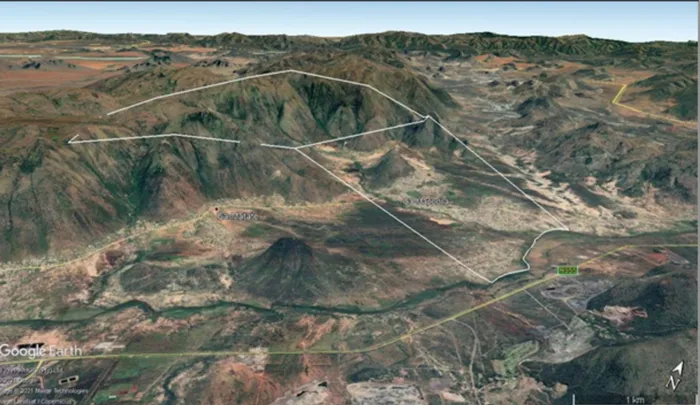
Northwest-facing view across the Eerste Geluk (foreground) and Nooitverwacht (vertical exaggerationis 2x) PGM mining prospect areas.. Southern Palladium has released a new optimised prefeasibility study for its Bengwenyama Project that significantly reduces capital costs.
Image: Image via the Southern Palladium website
Southern Palladium has released an Optimised Prefeasibility Study (OPFS) for its 70%-owned Bengwenyama Project that outlines a staged development approach that should reduce capital costs by $173 million (R3.1 billion) to $279m (R4.9bn) compared to the first study, presenting a “highly attractive option” for shareholders.
The board of the Australia and JSE-listed company said Thursday that the staged production option provides the best balance between unlocking project value and allows the company to fund project development with minimal future dilution for shareholders.
"We are pleased to announce the results of the OPFS for the Tier 1 Bengwenyama Project where our primary aim has been to reduce the initial capital requirement," said MD Johan Odendaal.
"The board and its consultants have evaluated a number of options and believe that a staged development provides a pragmatic and value-driven path forward."
Project level NPV (net present value) (after tax, 100% basis) for the OPFS was estimated at $857m (A$1.3bn), and an internal rate of return was at 26.4%. A staged production proposal assumed an initial Stage 1 production rate of 100ktpa expanding after 4 years to 200ktpa.
The peak funding requirement of $279m would represent a 38% reduction ($173m) to the peak funding total set out in the first feasibility study, while the proposed Stage 2 expansion capital would be funded through cash flow.
“Importantly, Stage 1 is expected to be a strongly cash-generative project in its own right, meaning it should be able to attract traditional market-related debt project financing. Cash costs for both Stage 1 and Stage 2 remain attractive and lie within the lowest quartile for PGM projects globally,” Odendaal said.
The valuations were done on the prefeasibility study basket price of $1 557/6Eoz, which is 6% below the basket price on July 7, 2025, of $1 662/6Eoz.
The option to utilise existing mineral processing infrastructure in the area could also result in further “significant” reductions to peak funding. The issue of the Mining Right was anticipated in the near term.
The OPFS was done because while the full-scale design outlined in the original pre-feasibility study was technically and economically compelling, the substantial upfront capital required could have posed a funding challenge, the board said.
“Importantly, the staged approach also improves our ability to further de-risk key geological, technical, and operational assumptions. Stage 1, designed to deliver over 200koz per year of PGMs in concentrate, will provide valuable insights into ground conditions and metallurgical performance, supporting more informed mine planning and optimised design for subsequent stages.”
It would also allow the project development with infrastructure roll-out and community readiness, ensuring a more sustainable and inclusive growth trajectory, the board said.
Stage 2 of the project was designed to deliver PGM production at levels forecast in the earlier study, averaging over 400koz per year for an aggregate mine life of over 20 years from year 4 or possibly sooner.
The project area is located in the Greater Tubatse and Sekhukhune District Municipalities, in the Limpopo Province, covering 5 280 hectares on the farms Nooitverwacht and Eerstegeluk.
The Bengwenyama Project is located near existing mining operations with established infrastructure, including processing plants, power supply, water supply, and well-maintained access roads, the board said.
The positive PGM market fundamentals had also fed through to higher prices recently. Towards the end of June 2025, platinum reached a 10-year high of just over $1 420/oz, after a prolonged decade period of being range-bound between $900-1 100/oz.
Visit: www.businessreport.co.za